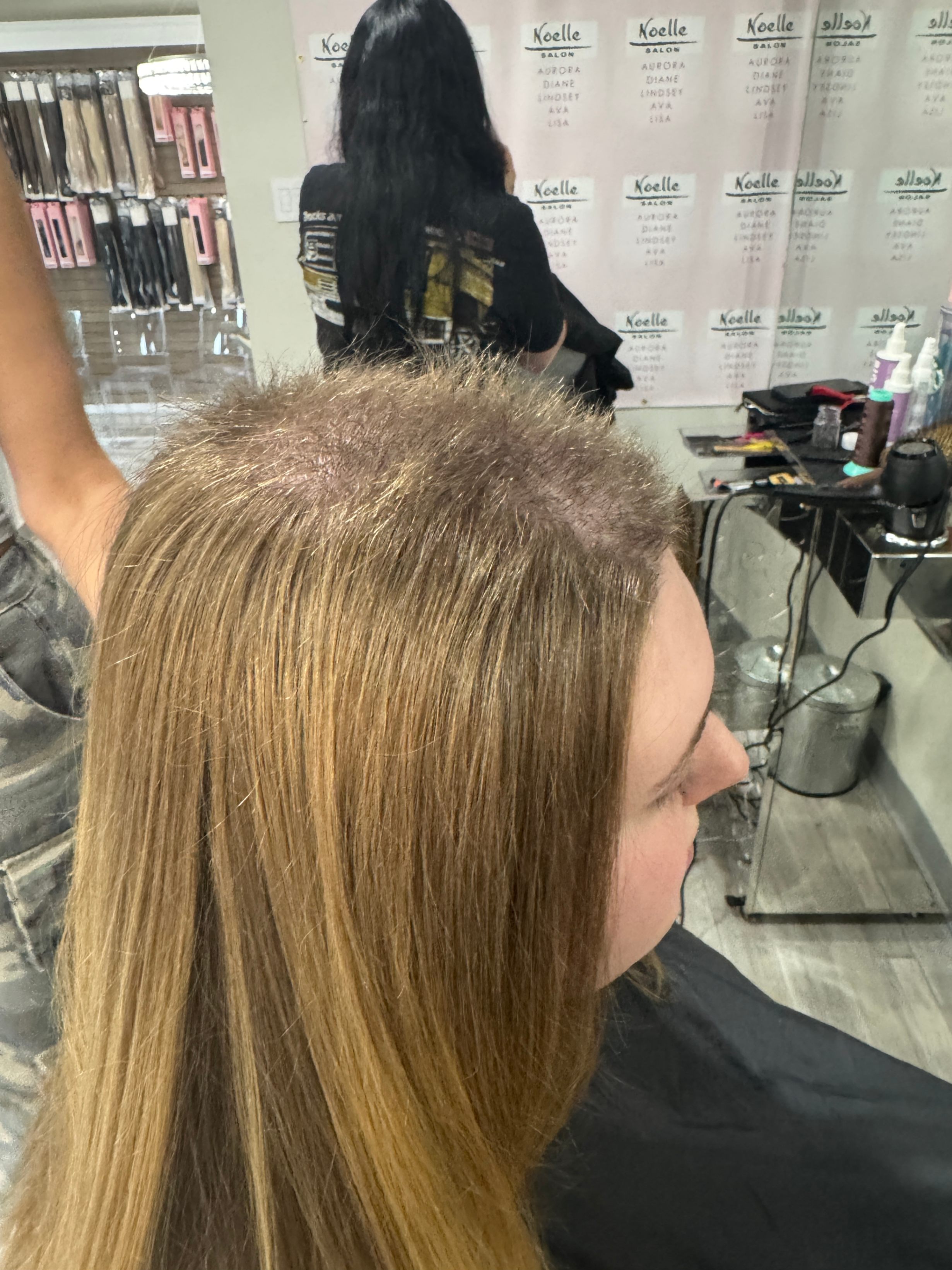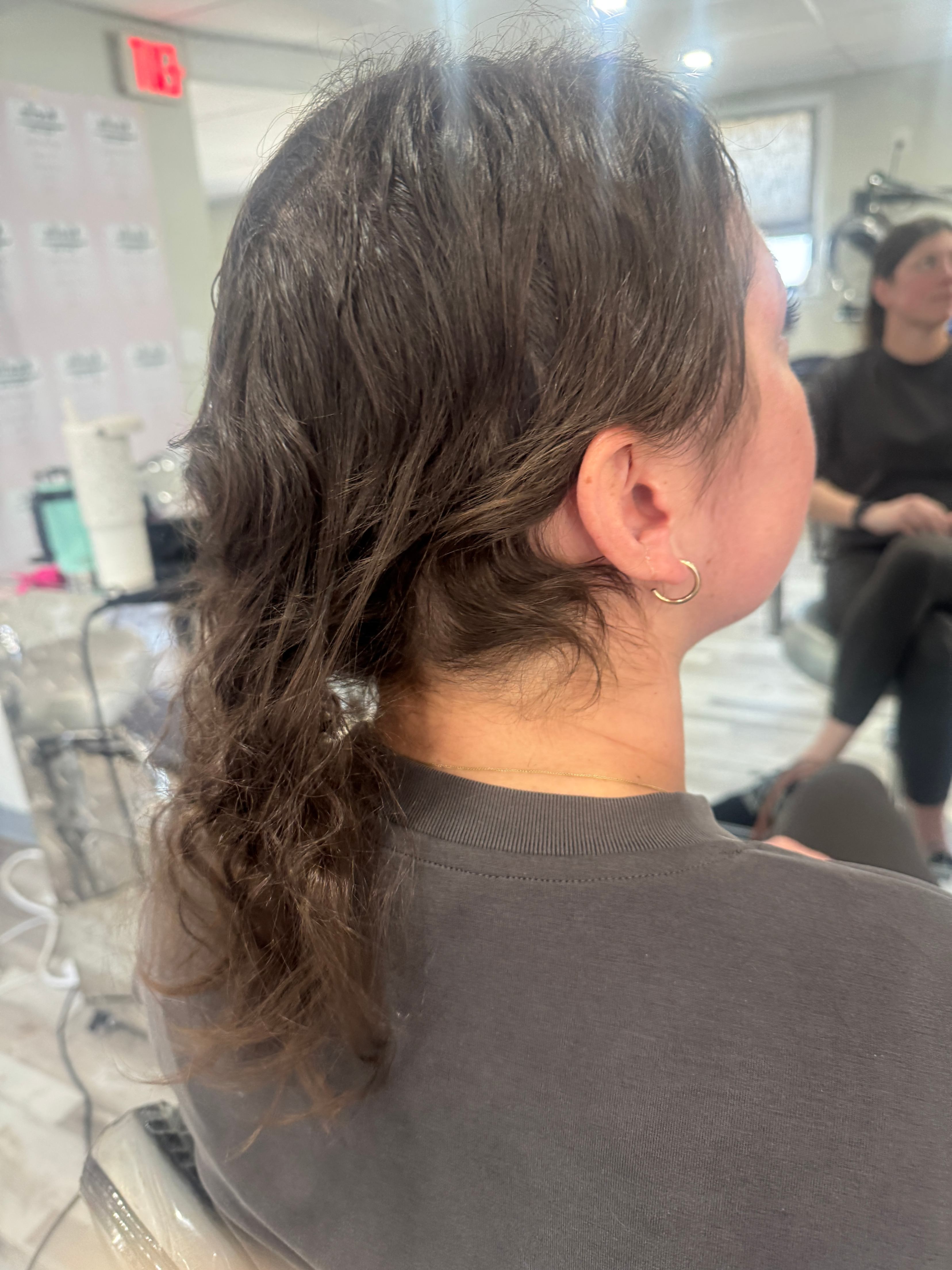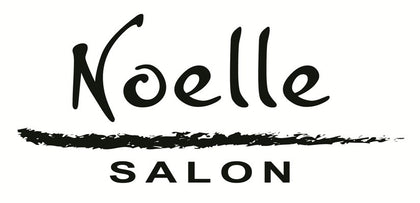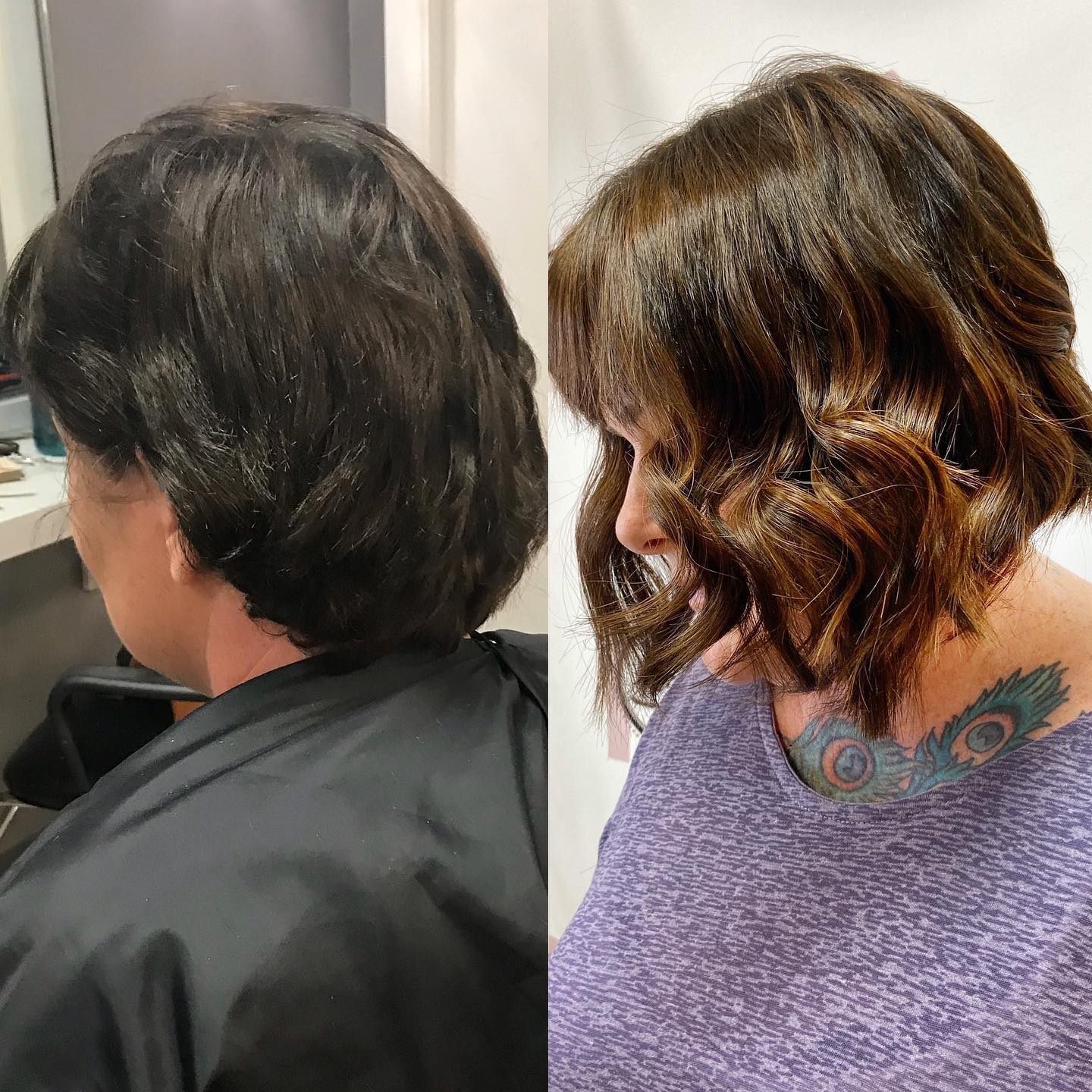Transform Your Look with Trichotillomania Hair Extensions
The application of hair extensions to trichotillomania clients is very important to understand. The below information will help when considering them.
The best approach to prepare for hair extension application begins with a free and private consultation where hair is evaluated to determine whether or not hair extensions or a hair system is suitable. Client's with all-over hair loss or patches are best suited for hair extensions, the method of hair extensions will vary based on hair density. I find many clients do not pull their hair while wearing hair extensions, they state that pulling on extensions does not give the same sensation as pulling on their own hair.

Determining Hair Extension Weight And Quantity
After qualifying our clients' needs, we then determine which method of extensions will work best to fill in the hair. A client with short hair may benefit from creating a slightly longer style. For example, below, a client with thick hair with diffuse hair loss, wanted a "style," so we created a long bob that blended with her own very short hair. We used Veila Pull-Thru hair extensions which give optimum volume and coverage. The Pull-Thru method does not utilize glue, tape, or sewing, they are very gentle on natural hair. Our goal is to help clients' hair grow and not promote further damage.
Individual Strand extensions work very well on clients with fine hair suffering from Trichotillomania because they are tiny and can be hidden in the hair. Clients with medium to thick hair can use tape-in hair extensions, pull-thru, or hand-tied hair because the aforementioned offer lots of hair per square inch.
The client pictured below has thick hair, her hair was filled with 2 packs of Veila Hair Extensions which weigh 100 grams. The length applied was 20 inches, and was cut to blend with her own hair. Her natural hair was colored to a warm brown, two-tone color (warm brown & caramel) hair extensions were applied.

Styling Options And Considerations
Hair extensions must be made of human hair, our hair is virgin (one-donor hair) creates the most natural blend. There are some extensions made of synthetic hair which is impossible to wash, style, and add thermal heat. Synthetic hair is made of plastic and will melt when heat is applied. Remy human hair extensions can be washed, dried, and styled like natural hair. We offer an array of styling products that assist with the styling process.
It is important to consider that hair extensions take a bit more effort to upkeep since there is more hair to deal with. The good news is that they hold an incredible curl, many clients wash their hair less often with their extensions. Using a dry shampoo to repel natural oil works very well in between shampoos.
Application And Client Feedback
The application process varies between one to four hours based on the amount of hair added. Our client's feedback has been quite favorable, most find their new look life-changing! Transforming a person's entire look and self-esteem is very rewarding. Hair extensions offer
"instant gratification," for all.
Hair Color and Styling with Hair Extensions
We often color our client's hair prior to applying for hair extensions and then match our extensions to their new hair color. In some instances, the client will opt to simply match their existing color which is perfectly fine.
Maintaining hair color is not a problem, we can color roots and/or highlight them while wearing extensions. Many hair extensions are reusable, (pull-thru, hand-tied & tape), therefore we remove the extensions, apply the color and reapply the hair extensions in one visit.
Styling Considerations:
1) It is important to dry the extensions, and use the recommended styling products.
2) When curling or flat ironing with thermal heat, the temperature of the implement should be at a medium setting. Excessively high heat (over 350 degrees) can cause breakage and compromise the longevity of the extensions.

Home Maintenance and Check-ups are Important
Maintenance is simple for most and will vary from person to person. If hair is oily, it will require more washing while thicker hair requires less. Ocean swimming is fine, but chlorinated water will damage hair. We suggest wearing a bathing cap. or avoiding getting the extensions wet. We give a written set of instructions to every client and we suggest a free two-week check-in to ensure the extensions are working well.
Consecutive visits will vary based on the extension method utilized, keratin hair extensions are removed and a new set applied. Other methods require "move-ups" and the hair extensions are re-used.
Note: There are certain types of hair extensions that do not address the situation well, which are offered by the likes of Bellami hair which offers tape-in extensions, or clip-in hair extensions even though they have a good color match palette. Clip-in ponytails can be a good occasional application if the client can manage it, styling with a natural curl is all part of the client's natural hair journey.
Hair extensions are a perfect way to fill in the "gaps" caused by hair loss due to Trich. We are interested in hearing from you, we love to collect data to make our client experience the best it can be. Feel free to post questions and feedback.
What are the symptoms of Trichotillomania?
Trichotillomania is characterized by a compelling urge to engage in hair pulling from various parts of the body, including eyelashes, leading to noticeable bald patches, particularly on the scalp. Individuals may experience considerable distress due to this hair-pulling behavior, which can often exacerbate feelings of anxiety and frustration. The presence of these bald patches not only affects a person's physical appearance but can also significantly impact their self-esteem and emotional well-being. Recognizing these symptoms is crucial for understanding the challenges faced by those with this disorder, as the act of pulling hair from the scalp often serves as a coping mechanism for managing stress or distressing emotions.
Moreover, it is essential to note that the severity of Trichotillomania can vary among individuals. Some may engage in pulling sporadically, while others might go to great lengths and do so more frequently, leading to more pronounced hair loss. This variability can make it challenging to address the disorder effectively, as treatment needs to be tailored to each person's unique experiences and levels of discomfort associated with their hair loss.
Is Trichotillomania manageable?
Managing Trichotillomania is a multifaceted process that often requires a combination of therapeutic interventions and coping strategies. While there is no definitive cure, individuals can achieve significant improvements in their condition. Many find that professional support, such as cognitive-behavioral therapy (CBT), can help them develop effective strategies to combat the urges to pull hair, addressing the underlying emotional distress that often drives the behavior.
In addition to therapy, many clients have reported that the use of hair extensions can serve as a practical solution. Extensions can help cover bald patches while simultaneously providing a distraction from the urge to pull. This method not only improves appearance but also reinforces positive self-image, which is crucial for hair regrowth and recovery. As clients embrace their new look, they often feel less compelled to engage in the pulling behavior, allowing for a gradual process of healing and hair regrowth.
Ultimately, the path to managing Trichotillomania involves a comprehensive approach that includes professional guidance, personal commitment, and the use of supportive tools like hair extensions, as well as exploring various treatment options. Through this process, individuals can reclaim control over their hair and enhance their overall quality of life.
Maintenance With Trichotillomania Clients
Considerations When Using Extensions for Trichotillomania
When considering hair salons, hair extensions, and hair care for clients with Trichotillomania, several important factors must be taken into account to ensure both comfort and effectiveness. First and foremost, the choice of hair extensions should align with the client's natural hair type and condition. For instance, clients with fine hair may benefit from individual strand extensions that can be discreetly integrated, while those with thicker hair might find tape-in or hand-tied extensions more suitable. The objective is to provide coverage for bald patches, particularly on the crown area, while maintaining a natural appearance.
Consideration
Description
Hair Type
Match extensions to the client's natural hair type for seamless blending.
Application Method
Choose methods that minimize damage to natural hair, such as pull-thru or tape-ins.
Maintenance
Establish a maintenance routine to ensure the longevity of extensions while protecting natural hair.
Furthermore, the application process should be handled with care. Gentle application techniques are essential to avoid discomfort or potential exacerbation of pulling urges. Regular maintenance check-ups are also critical, as they help monitor the health of both the extensions and the natural hair beneath. By taking these considerations into account, hair extensions can serve as a valuable tool for clients dealing with Trichotillomania, providing them with the confidence and support they need to manage their condition effectively.




